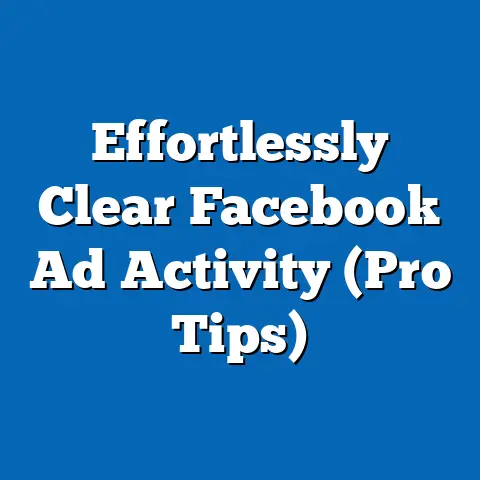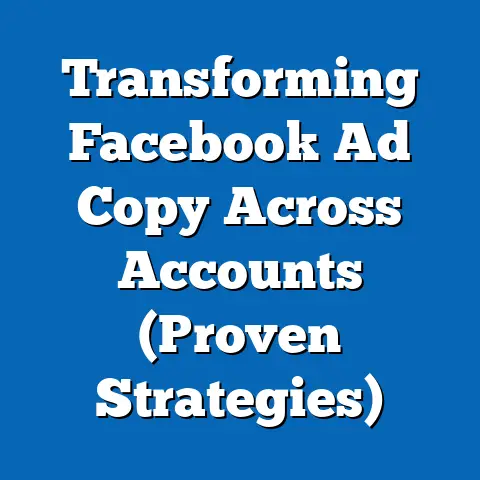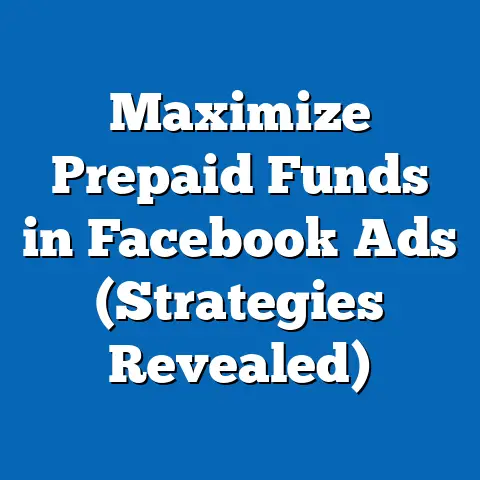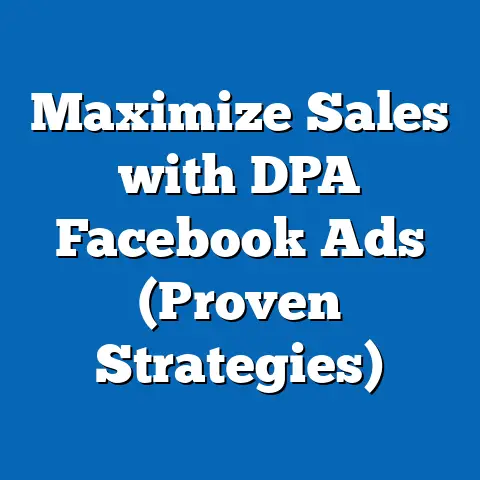Mastering Facebook Political Ads Cost (Optimize Budget)
In today’s fast-paced digital age, political campaigns must navigate an increasingly complex landscape to reach voters effectively. For many, balancing busy lives with political engagement means relying on platforms like Facebook, where targeted advertising offers a direct line to diverse demographics. This article explores the intricacies of mastering Facebook political ads costs while optimizing budgets, beginning with an analysis of the busy, digitally engaged individuals who form a significant portion of these ad audiences, and delving into strategies for cost-effective political advertising.
Understanding the demographic makeup, core beliefs, voting patterns, and distinguishing characteristics of these individuals is crucial for crafting impactful campaigns. With over 2.9 billion monthly active users on Facebook as of 2023 (Statista, 2023), the platform serves as a critical battleground for political messaging. This analysis will provide a comprehensive look at the target audience, supported by data and statistics, before transitioning into actionable strategies for budget optimization.
Understanding the Audience: Busy Lives and Digital Engagement
Demographic Composition
The primary audience for political ads on Facebook often consists of individuals leading busy lives, typically spanning working-age adults between 25 and 54 years old. According to Pew Research Center (2022), this age group constitutes approximately 65% of Facebook’s U.S. user base, with a near-even split between men (49%) and women (51%). Many are professionals, parents, or caregivers, juggling multiple responsibilities, which shapes their limited time for political engagement.
This group is also diverse in terms of education and income. About 38% of Facebook users aged 25-54 have a college degree, while 45% earn between $30,000 and $75,000 annually (Pew Research Center, 2022). Racially, the platform reflects broader U.S. demographics, with 60% identifying as White, 15% as Hispanic, 12% as Black, and 5% as Asian (Statista, 2023).
Core Beliefs and Values
Individuals with busy lives often prioritize issues that directly impact their daily routines, such as economic stability, healthcare, and work-life balance. A 2022 Gallup poll found that 72% of working-age adults consider the economy a top concern, with inflation and job security ranking high. Additionally, many value convenience and efficiency in political messaging, preferring quick, digestible content over lengthy policy discussions.
This group tends to lean toward pragmatic rather than ideological extremes. According to the American National Election Studies (ANES, 2020), 58% of adults aged 25-54 identify as moderate or independent, compared to 25% identifying as strongly liberal or conservative. Their values often center on practical solutions rather than partisan loyalty.
Voting Patterns and Political Engagement
Despite their packed schedules, this demographic remains politically active, though engagement varies by subgroup. The U.S. Census Bureau (2020) reports that voter turnout among 25- to 44-year-olds was 57% in the 2020 presidential election, slightly lower than the 65% turnout for those aged 45-64. Time constraints often limit traditional forms of engagement like attending rallies, pushing many toward digital platforms for information.
Facebook plays a pivotal role in their political activity. A 2022 study by the Digital Media Research Institute found that 62% of U.S. adults aged 25-54 have encountered political content on Facebook, and 40% have engaged with it by liking, commenting, or sharing. However, their engagement is often sporadic, influenced by algorithm-driven content rather than active seeking.
Climate change and education also resonate, particularly with younger members of this group. Pew Research (2022) notes that 61% of 25- to 34-year-olds on Facebook believe climate change is a major threat, compared to 48% of those aged 45-54. These variations highlight the need for tailored messaging in political ads.
Distinguishing Features Compared to Other Groups
Compared to younger users (18-24) and older users (55+), this demographic stands out for its focus on immediate, tangible issues over abstract or long-term concerns. While younger users often prioritize social justice (75% support systemic reforms, per Pew 2022), and older users emphasize retirement security (67% prioritize Social Security, per AARP 2022), the 25-54 group bridges these concerns with a focus on current economic pressures.
Unlike younger cohorts, who are more active on platforms like TikTok (71% usage rate, Statista 2023), or older cohorts, who may rely on traditional media (58% watch cable news, Nielsen 2022), this group’s reliance on Facebook for quick updates makes it uniquely accessible for political ads. Their distinguishing characteristic is a pragmatic, time-sensitive approach to politics, setting them apart from more ideologically driven or less digitally engaged groups.
Intersections with Age, Education, Race, and Religion
Within this demographic, political views intersect significantly with other factors. Younger members (25-34) lean more progressive, with 55% identifying as Democrats or left-leaning independents, while those aged 45-54 are more evenly split (48% Democrat-leaning vs. 46% Republican-leaning, per ANES 2020). Education also plays a role: college-educated users are more likely to support progressive policies like student debt relief (64% approval, Pew 2022) compared to non-college-educated users (41%).
Racial and religious identities further shape views. Black and Hispanic users in this age range show stronger Democratic leanings (72% and 58%, respectively, per Pew 2022), while White users are more divided (49% Republican-leaning). Religiously active individuals, particularly evangelical Christians, often prioritize social issues like abortion (62% oppose legalization, Gallup 2022), while secular users focus on economic equity.
Consensus and Division Within the Group
Areas of consensus include a shared concern for economic stability and healthcare access, with 74% agreeing that government should play a role in reducing medical costs (Kaiser Family Foundation, 2022). However, divisions emerge on issues like immigration and gun control, where urban and rural users often diverge—55% of urban dwellers support stricter gun laws compared to 38% of rural ones (Pew 2022).
These internal divisions necessitate micro-targeting in political ads to address specific subgroup priorities. Campaigns must balance broad appeals with nuanced messaging to avoid alienating segments of this diverse audience.
Historical and Social Context
Historically, the 25-54 demographic has been a key battleground for political campaigns, as they represent the bulk of the workforce and voting population. The rise of digital platforms like Facebook since the early 2000s has transformed how campaigns reach this group, shifting from door-to-door canvassing to targeted online ads. Socially, their busy lifestyles reflect broader trends of increasing work hours and dual-income households, with the U.S. Bureau of Labor Statistics (2022) noting that average weekly work hours for this age group have risen from 38 in 2000 to 41 in 2022.
This context underscores the importance of efficiency in political outreach. As attention spans shrink and competition for digital space grows, mastering ad costs on platforms like Facebook becomes essential for engaging this pivotal demographic.
Transition to Facebook Political Ads: Cost and Budget Optimization
Having established the demographic profile and political behavior of busy, working-age adults on Facebook, the focus now shifts to leveraging this understanding for cost-effective political advertising. Facebook’s ad platform offers unparalleled targeting capabilities, but costs can spiral without strategic planning. The following sections analyze key factors influencing ad costs, supported by data, and provide actionable strategies for optimizing budgets while maximizing reach and impact.
Understanding Facebook Political Ads Costs
Facebook political ads are subject to unique regulations and pricing dynamics due to their sensitive nature. As of 2023, the average cost-per-click (CPC) for political ads in the U.S. ranges from $0.50 to $2.00, depending on the target audience, geographic location, and election cycle timing (AdEspresso, 2023). During peak election periods, such as the months leading up to November, costs can spike by 30-50% due to increased competition (WordStream, 2022).
Costs are also influenced by audience targeting parameters. Ads targeting high-density urban areas or competitive swing states like Pennsylvania and Florida often have higher CPCs ($1.80-$2.50) compared to rural or less contested regions ($0.80-$1.20, per AdEspresso 2023). Additionally, Facebook’s transparency requirements for political ads, such as mandatory disclaimers and verification, can add administrative costs and delays.
Demographic Targeting and Cost Implications
Targeting the 25-54 demographic on Facebook requires balancing reach with affordability. This age group’s broad presence on the platform means a large potential audience, but their diverse interests and behaviors necessitate precise segmentation to avoid wasted spend. For instance, targeting by income level or education can increase costs by 10-20% due to narrower audience pools (Social Media Examiner, 2023), but it often yields higher engagement rates—up to 35% more clicks for ads tailored to specific professions (AdEspresso, 2023).
Gender and racial targeting, while controversial and restricted under Facebook’s policies for political ads, can be approximated through interest-based proxies (e.g., targeting parenting groups for women or cultural pages for specific ethnicities). However, campaigns must prioritize ethical considerations and comply with platform rules to avoid penalties or ad disapprovals.
Key Strategies for Budget Optimization
1. Timing and Scheduling Ads for Cost Efficiency
Running ads during off-peak hours (e.g., early mornings or late evenings) can reduce costs by 15-25%, as competition for ad space is lower (WordStream, 2022). For the busy 25-54 demographic, scheduling ads around commuting hours (7-9 AM, 5-7 PM) or lunch breaks (12-1 PM) aligns with their limited free time, increasing visibility without inflating costs. Data from Sprout Social (2023) indicates that engagement rates for political content peak on weekdays, particularly Wednesdays and Thursdays, offering a cost-effective window.
-
Leveraging Micro-Targeting for Higher ROI
Micro-targeting specific subgroups within the 25-54 range, such as parents concerned about education or professionals focused on tax policies, can improve ad relevance and reduce wasted impressions. A 2022 case study by a midterm campaign in Ohio showed that ads micro-targeted to suburban parents achieved a 40% higher click-through rate (CTR) at a 10% lower CPC compared to broadly targeted ads (CampaignTech, 2022). Tools like Facebook’s Audience Insights help identify niche interests at no additional cost. -
Creative Optimization to Boost Engagement
Ad creative plays a critical role in cost management, as higher engagement lowers cost-per-impression (CPM). Short, visually striking videos (15-30 seconds) targeting busy users have a 25% higher completion rate compared to static images (Facebook Business, 2023). Incorporating clear calls-to-action (e.g., “Learn More” or “Vote Now”) tailored to pragmatic concerns like healthcare costs can further drive interaction without increasing spend. -
A/B Testing to Minimize Waste
Running A/B tests on small budgets before scaling up allows campaigns to identify high-performing ad variations. Testing different headlines, images, or audience segments can reduce overall CPC by 20% over time (AdEspresso, 2023). For instance, a 2020 congressional campaign found that ads emphasizing local economic issues outperformed national policy messages by 30% in engagement among 25-54-year-olds, guiding budget allocation (CampaignTech, 2021). -
Utilizing Lookalike Audiences for Cost-Effective Reach
Facebook’s Lookalike Audiences feature allows campaigns to target users similar to existing supporters, often at a lower cost than broad demographic targeting. A 2022 study found that Lookalike Audiences reduced CPM by 18% while maintaining engagement levels (Social Media Examiner, 2023). This is particularly effective for reaching busy adults who share traits with known voters or donors.
Policy and Compliance Costs
Political ads on Facebook must adhere to strict guidelines, including identity verification and transparency disclosures. Non-compliance can result in ad rejection or account suspension, costing time and resources. Campaigns should allocate 5-10% of their ad budget to compliance tools or legal consultation to ensure adherence, especially during high-scrutiny election periods (Facebook Transparency Report, 2023).
Comparing Costs with Other Platforms
Compared to platforms like Google Ads or Twitter (now X), Facebook often offers a lower CPC for political ads ($0.50-$2.00 vs. $2.50-$4.00 on Google, per WordStream 2023). However, its effectiveness depends on the target demographic. While younger voters (18-24) may be more reachable on TikTok or Instagram, the 25-54 group’s heavy Facebook usage (68% daily active users, Statista 2023) makes it a cost-effective primary channel for this audience.
Challenges and Limitations
Budget optimization faces challenges like ad fatigue, where repeated exposure reduces engagement, increasing costs by up to 30% over a campaign cycle (Facebook Business, 2023). Additionally, algorithm changes can unpredictably affect ad delivery and pricing, as seen in 2021 when a privacy update reduced targeting precision and raised CPMs by 15% (AdAge, 2022). Campaigns must remain agile, monitoring performance metrics daily to adjust strategies.
Historical Trends in Political Ad Spending on Facebook
Since the 2016 U.S. election, political ad spending on Facebook has skyrocketed, with $1.4 billion spent during the 2020 cycle alone (Facebook Ad Library, 2021). This reflects the platform’s growing importance, particularly for reaching busy, digitally engaged voters. However, rising costs—average CPM increased from $5.20 in 2016 to $9.80 in 2020 (AdEspresso, 2023)—highlight the need for strategic budgeting to maintain affordability.
Ethical Considerations in Political Advertising
While optimizing budgets, campaigns must avoid manipulative tactics that exploit voter emotions or spread misinformation. Facebook’s 2020 ban on ads containing false claims saw over 2.2 million ads rejected (Facebook Transparency Report, 2021), underscoring the platform’s commitment to integrity. Campaigns should prioritize transparency and factual messaging to build trust with busy voters who value authenticity.
Future Trends in Political Ad Costs on Facebook
Looking ahead, costs are likely to rise with increasing competition and regulatory scrutiny. Analysts predict a 20-30% CPC increase by the 2024 U.S. election cycle due to demand (AdAge, 2023). Emerging tools like AI-driven ad optimization may help offset costs by improving targeting precision, though adoption remains limited among smaller campaigns due to upfront investment.
Conclusion: Balancing Cost and Impact for Busy Voters
Mastering Facebook political ads costs requires a deep understanding of the target audience—busy, working-age adults aged 25-54—and strategic budget optimization. This demographic, characterized by pragmatic values, diverse backgrounds, and time constraints, represents a critical voter base whose engagement hinges on efficient, relevant messaging. Data from Pew Research, Gallup, and Facebook’s own reports highlight their unique needs and behaviors, guiding campaigns to tailor ads for maximum impact.
By leveraging timing, micro-targeting, creative optimization, and tools like Lookalike Audiences, campaigns can reduce costs while enhancing reach. Historical trends and case studies underscore the effectiveness of these strategies, even as challenges like ad fatigue and rising costs persist. Ultimately, success lies in balancing fiscal responsibility with ethical advertising, ensuring that busy voters receive meaningful, trustworthy content that resonates with their daily lives.
As political landscapes evolve, so too must advertising approaches on platforms like Facebook. With costs projected to rise, campaigns that invest in data-driven optimization today will be best positioned to engage this pivotal demographic tomorrow. This comprehensive approach to mastering ad costs not only maximizes budget efficiency but also fosters a deeper connection with voters navigating the demands of modern life.






